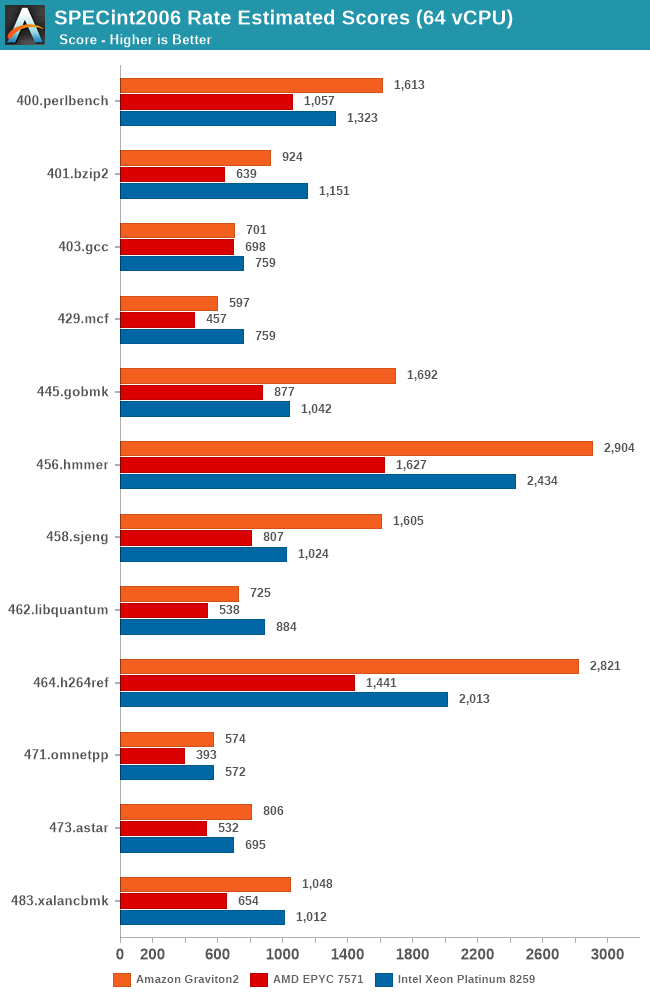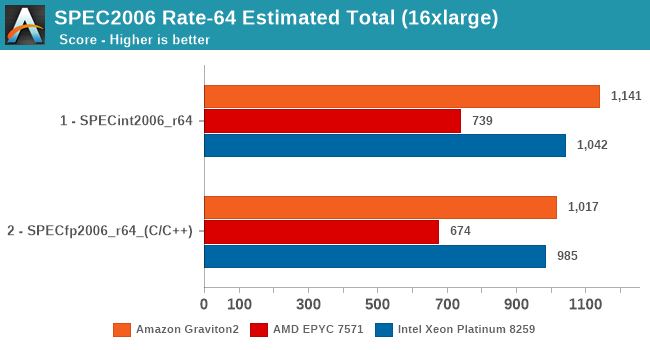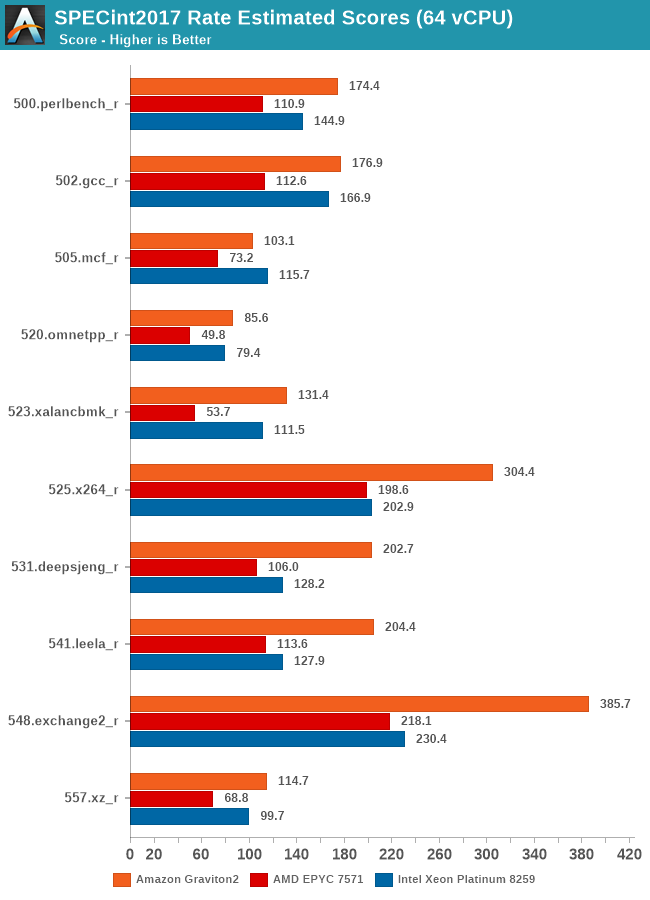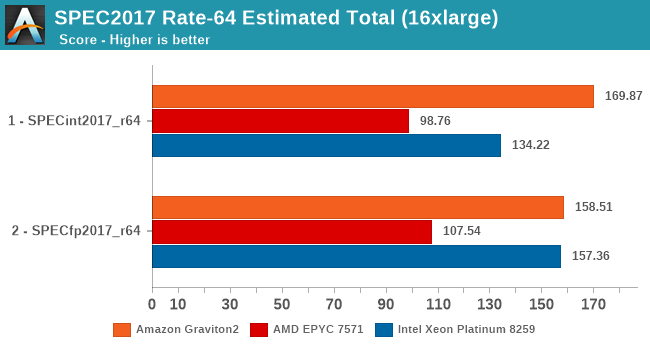Amazon's Arm-based Graviton2 Against AMD and Intel: Comparing Cloud Compute
by Andrei Frumusanu on March 10, 2020 8:30 AM EST- Posted in
- Servers
- CPUs
- Cloud Computing
- Amazon
- AWS
- Neoverse N1
- Graviton2
SPEC - MT Performance (16xlarge 64vCPU)
While the core scaling figures are interesting from an academical standpoint, what’s even more interesting is seeing the absolute throughput numbers compared to the competition. We’re starting off with SPECrate results with 64-rate runs, fully utilising the vCPUs of the EC2 16xlarge instances.
Again, there’s the conundrum of the apples-and-oranges comparison between the Graviton2’s 64 physical cores versus the 32 cores plus SMT setups of the AMD and Intel platforms, but again, that’s how Amazon is positioning these systems in terms of throughput capacity and instance pricing. You could argue that if you can parallelise your workload above a certain amount of threads, it doesn’t matter on whether you can achieve the higher throughput through more cores or through mechanisms such as SMT. Remember, when talking about silicon die area, you could at minimum probably fit 2 N1 cores in the same area than an AMD Zen core or an Intel core (probably an even higher number in the latter comparison).

The Graviton2’s performance is absolutely impressive across the board, beating the Intel Cascade Lake system by quite larger margins in a lot of the workloads. AMD’s Epyc system here doesn’t fare well at all and is showing its age.

It’s particularly in the non-memory bound workloads that the Graviton2 manages to position itself significantly ahead, and here the advantage of having a two-fold physical core lead with essentially double the execution resources shows its benefits.

In the overall SPECrate2006 results, the Graviton2 is shy of Arm’s projection of a 1300 score, but again the Amazon chip does clock in a bit lower and has less cache than what Arm had envisioned in their presentations a year ago.
Nevertheless, the Graviton2 has the performance lead here even against the Intel Cascade Lake based EC2 instances, which is quite surprising given the latter’s cost structure, and indicator of what to come later in the cost analysis.

Arm’s physical core count advantage here continues to show in the execution intensive workloads of SPECint2017, showcasing some very large performance leads in many workloads. The performance leap on important workloads such as 502.gcc again isn’t too great over the Intel system for example – Amazon and Arm definitely could do better here if the chip would have had more cache available.

In SPECfp2017, there’s more workloads in which the Xeon system’s 2-socket setup with a 50% memory channel advantage does show up, able to result in more available bandwidth and thus give the more memory intensive workloads in this suite a good performance advantage over the Graviton2 system. Still, the Arm chip fares very competitively and does put the older AMD EPYC processor in its place, and yes again, we have to remind ourselves that things would be quite different here if we’d be able to include Rome in our charts.

Overall, the Graviton2 system has an undisputed lead in the SPECint2017 suite, whilst just edging out on average the Xeon system in the FP suite, only losing out in situations where the Xeon’s higher memory bandwidth comes at play.










96 Comments
View All Comments
Wilco1 - Friday, March 13, 2020 - link
Developing a chip based on a standard Arm core is much cheaper. Arm chip volumes are much higher than Intel and AMD, the costs are spread out over billions of chips.ksec - Tuesday, March 10, 2020 - link
ARM's licensing comparatively speaking is extremely cheap even for their most expensive N1 Core Blueprint. The development and production cost are largely on ARM's because of the platform model. So Amazon is only really paying for the cost to Fab with TSMC, I would be surprised if those chip cost more than $300. Which is at least a few thousand less than Intel or even AMD.Amazon will have to paid for all the software cost though. Making sure all their tools, and software runs on ARM. That is very expensive in engineering cost, but paid off in long term.
extide - Friday, March 13, 2020 - link
Actual production cost is going to be more like $50 or so. WAY less than $300.ksec - Monday, March 30, 2020 - link
Only the Wafer Cost alone would be $50+ assuming 100% yield. That is excluding licensing and additional R&D. At their volume I would not be surprised it stack up to $300FunBunny2 - Tuesday, March 10, 2020 - link
"Vertical integration is powerful."I find it amusing that compute folks are reinventing the wheel from Henry Ford!! River Rouge.
mrvco - Tuesday, March 10, 2020 - link
It would be interesting to see how the AWS instances compare to performance-competitive Azure instances on a value basis.kliend - Tuesday, March 10, 2020 - link
Anecdotally, Yes. Amazon is always trying to bring in users for little/no immediate profit.skaurus - Tuesday, March 10, 2020 - link
At scale, predictability is more important in infrastructure than cost. It may seem that if we have everything we need compiled for Arm, we can just switch over. But these things often look easier in theory than practice. I'd be wary to move existing service to Arm instances, or even starting a new one when I just want to iterate fast and just be sure that underlying level doesn't have any new surprises.It will be fine If I have time to experiment, or later, when the dust settles. Right now, I doubt that switching over to these instances once they are available, is actually easy or even smart decision.
FunBunny2 - Tuesday, March 10, 2020 - link
"It may seem that if we have everything we need compiled for Arm, we can just switch over. But these things often look easier in theory than practice. "with language compliant compilers, I don't buy that argument. it can certainly be true that RISC-ier processors yield larger binaries and slower performance, but real application failure has to be due to OS mismatches. C is the universal assembler.
mm0zct - Wednesday, March 11, 2020 - link
Beware that in C struct packing is ABI dependent, if you write out a struct to disk on x86_64, and try and read it back in on Aarch64, you might have a bad time unless you use the packed pragma and use specified-width types. This is the sort of thing that might get you if you try to migrate between architectures.Also many languages (including C) have hand optimised math libraries with inline assembler, which might still be using plain-C fallbacks on other architectures. There was a good article discussing the migration to Aarch64 at Cloudflare, they particulary encountered issues with go not being optimised on Aarch64 yet https://blog.cloudflare.com/arm-takes-wing/